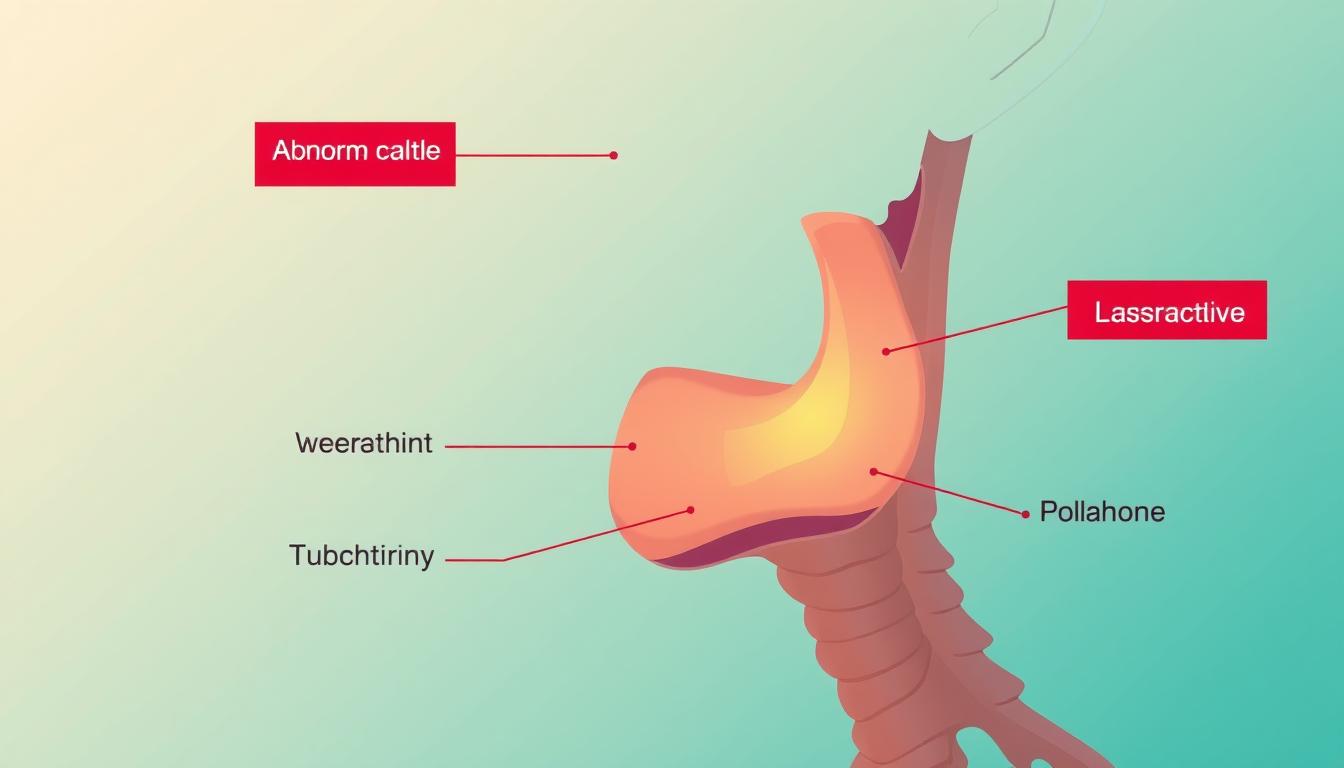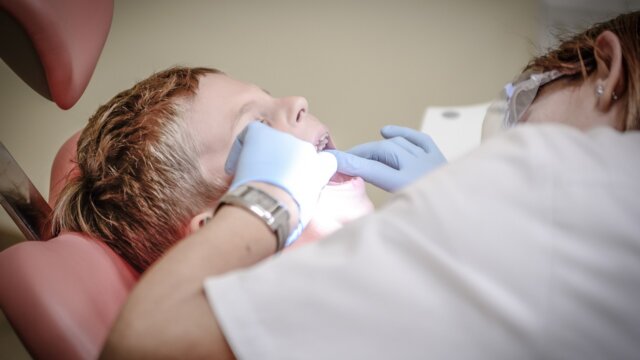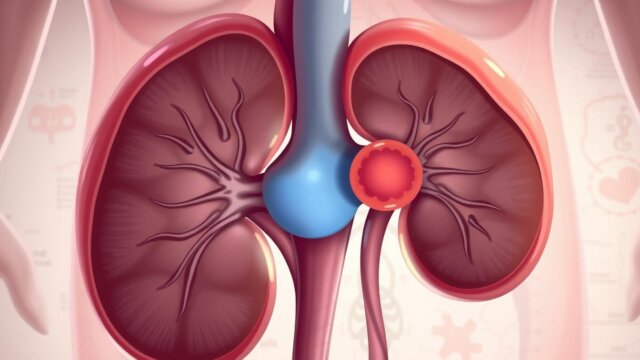FTC disclaimer: This post may contains affiliate links and we will be compensated if you click on a link and make a purchase.
Laryngeal cancer, also known as throat cancer or voice box cancer, affects over 2,000 people in the UK each year. It mainly hits people over 60. Men are four times more likely to get it than women.
While the outlook is good, with 65 out of 100 people surviving 5 years after diagnosis, knowing the causes and symptoms is key. This helps catch it early and treat it well.
Key Takeaways
- Laryngeal cancer is a type of throat cancer that affects the voice box (larynx).
- It is more common in men and older adults, with a higher risk for those who smoke or drink heavily.
- Early symptoms include hoarseness, sore throat, and difficulty swallowing, while advanced symptoms may include a lump in the neck and breathing difficulties.
- Risk factors include tobacco use, excessive alcohol consumption, HPV infection, and occupational exposure to certain chemicals and substances.
- Prompt diagnosis and appropriate treatment, such as radiation therapy, surgery, and chemotherapy, are crucial for the best outcomes.
What is Laryngeal Cancer?
Definition and Overview
Laryngeal cancer starts in the larynx, also known as the voice box. Most cases are squamous cell carcinomas (SCC) that start on the mucosal surface. The larynx is at the windpipe’s entrance and is key for breathing and speaking. It has vocal cords that vibrate to make sound.
Anatomy of the Larynx
The larynx is complex and vital for airway protection, breathing, and making sound. It has cartilages, muscles, and membranes that work together. Knowing the larynx’s anatomy helps us understand how cancer affects it.
Structure | Function |
|---|---|
Thyroid Cartilage | Provides the main framework for the larynx and protects the vocal cords. |
Cricoid Cartilage | Supports the trachea and forms the base of the larynx. |
Vocal Cords | Vibrate to produce sound for speech. |
Epiglottis | Covers the larynx during swallowing to prevent food and liquids from entering the airway. |
Knowing the larynx’s anatomy and function is key. It helps us see how laryngeal cancer can affect breathing, swallowing, and speaking.
Symptoms of Laryngeal Cancer
Finding laryngeal cancer early is key to better treatment and results. A common sign is a hoarse or changed voice that lasts more than 3 weeks. You might also feel a sore throat, pain when swallowing, or a lump in the throat.
Advanced Symptoms
As cancer grows, symptoms get worse. You might cough a lot, have trouble breathing, ear pain, or lose weight without trying. If your voice or swallowing changes, see a doctor right away.
Laryngeal cancer hits men more than women. It’s also more common in older people, especially those over 55.
“Early detection of laryngeal cancer is crucial for effective treatment and improved outcomes.”
If you notice these symptoms, get checked by a doctor. Quick action can lead to the right diagnosis and treatment.
Causes and Risk Factors
The exact cause of laryngeal cancer is still unknown. But we know many risk factors that can increase your chance of getting it. Tobacco use and heavy alcohol consumption are the biggest risks. The more you smoke and drink, the higher your risk.
Other risks include a family history of head and neck cancers. Weakened immune systems, like those with HIV/AIDS, also raise the risk. Having had lung, esophageal, or bladder cancer before is another risk factor.
Being exposed to harmful substances like asbestos and sulfur mustard gas also increases your risk.
Helicobacter pylori infection and gastro-oesophageal reflux disease (GORD) are linked to higher risks too. People with laryngeal dysplasia are at a much higher risk.
Men are 4 to 5 times more likely to get laryngeal cancer than women. More than half of cases are in people aged 65 or older. Rates are also higher in African Americans and whites than in Latinos and Asians.
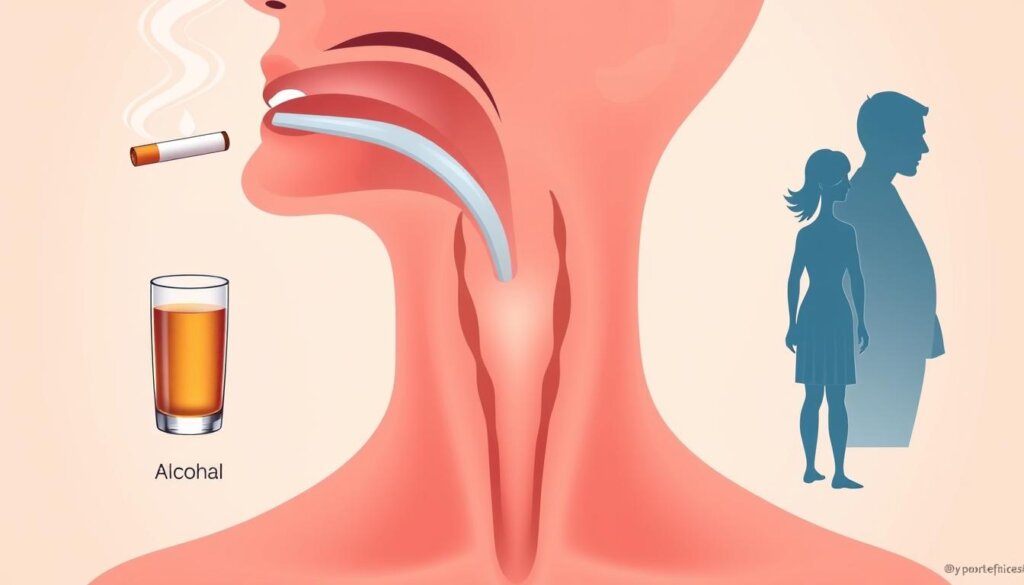
In summary, many risk factors have been found for laryngeal cancer. These include tobacco use, alcohol consumption, family history, weakened immunity, and more. Understanding and reducing these risks is key to preventing and managing this cancer.
“The more you smoke and drink, the higher your risk of developing laryngeal cancer.”
Laryngeal Cancer and Family History
If a first-degree relative, like a parent or sibling, has head or neck cancer, your risk of laryngeal cancer doubles. This hints at a possible genetic link. But, scientists are still studying the exact genes involved.
Having a family history of laryngeal cancer raises your risk. But, staying healthy by avoiding tobacco and alcohol can lower your risk. Eating lots of fruits and veggies, like the Mediterranean diet, might also help.
Most laryngeal or hypopharyngeal cancers aren’t caused by inherited genes. Instead, gene changes usually happen during a person’s life, not inherited. Yet, some people might inherit a weaker ability to fight off cancer-causing chemicals.
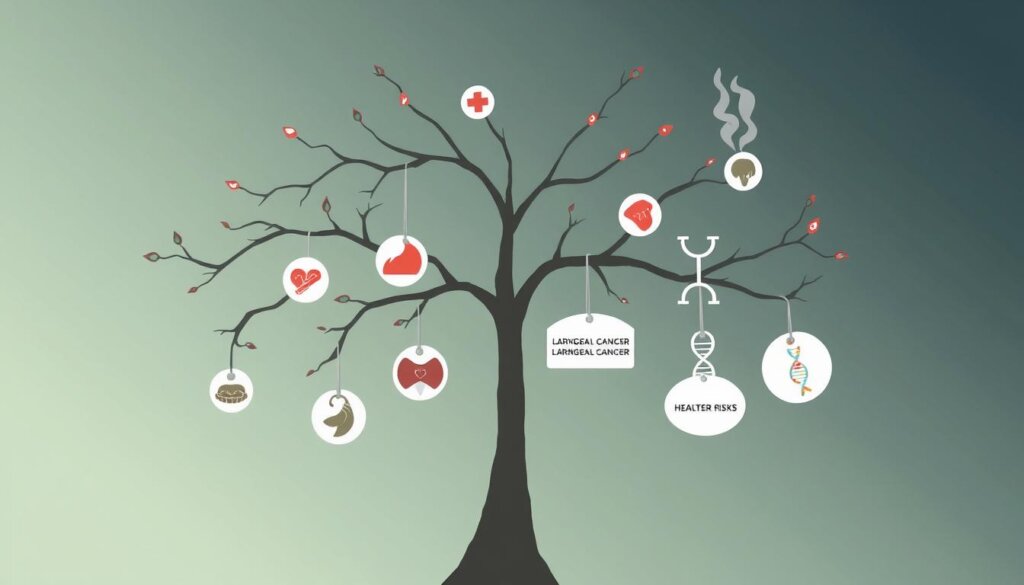
If you have a family history of laryngeal cancer, talk to your doctor. They might suggest more tests or steps to keep you healthy.
Even with a family history, a healthy lifestyle and regular check-ups can lower your risk of laryngeal cancer.
Diet and Laryngeal Cancer Risk
Your diet might affect your chance of getting laryngeal cancer. Eating a lot of red meat, processed foods, and fried foods could raise your risk. But eating more fruits and veggies might help protect you. The Mediterranean diet, with its focus on fruits, veggies, whole grains, and healthy fats, is linked to lower cancer risk.
Role of Fruits and Vegetables
Eating more fruits and veggies, which are rich in antioxidants, might lower your cancer risk. These foods are full of good stuff like vitamins, minerals, and phytochemicals. Adding them to your diet can help keep your body strong against cancer.
Dietary Factor | Impact on Laryngeal Cancer Risk |
|---|---|
High intake of red meat, processed foods, and fried items | Increased risk |
Mediterranean diet (high in fruits, vegetables, whole grains, and healthy fats) | Decreased risk |
Increased intake of antioxidant-rich fruits and vegetables | Potential risk reduction |
“Incorporating more nutrient-dense fruits and vegetables into your diet may be a simple yet effective way to support your body’s defenses against laryngeal cancer.”
By choosing what you eat, you can lower your risk of laryngeal cancer. Eating a diet full of plants and following the Mediterranean diet can help keep you healthy. It also makes you less likely to get this cancer.
HPV and Laryngeal Cancer
The human papillomavirus (HPV) is linked to a higher risk of laryngeal cancer. It’s the main cause of cervical cancer. Researchers think HPV might also affect throat and larynx cells, leading to cancer. HPV spreads through sexual contact, including oral sex.
Studies show different rates of HPV in laryngeal cancer. A 1996 study by Almadori et al. found HPV DNA in 32% of cases. But, a 1999 study by Lindeberg and Krogdahl found HPV in only a few cases. A 2017 study by Chen et al. found HPV16 DNA in 48% of cases.
More research has looked into HPV and laryngeal cancer. A 2013 study by Li et al. found a strong link between HPV and laryngeal cancer. A 2018 study by Tong et al. looked at HPV in laryngeal cancer in Northeast China.
Study | Findings |
|---|---|
Almadori et al. (1996) | HPV DNA detected in 32% of laryngeal squamous cell carcinoma |
Lindeberg and Krogdahl (1999) | HPV is absent in the majority of laryngeal carcinomas |
Chen et al. (2017) | 48% prevalence of HPV16 DNA and integration in normal and malignant laryngeal epithelium |
Li et al. (2013) | Significant association between HPV infection and laryngeal cancer risk |
Tong et al. (2018) | Investigated prevalence and prognostic significance of HPV in laryngeal squamous cell carcinoma in Northeast China |
HPV’s role in laryngeal cancer is still being studied. Some studies have found a strong link, while others have found little to no HPV. This shows we need more research to understand HPV’s role in laryngeal cancer.
Occupational Exposures
Certain jobs can increase your risk of getting laryngeal cancer. People who work with harmful stuff like asbestos, coal dust, or chemicals are at higher risk. These things can hurt the cells in your larynx, leading to cancer over time.
Asbestos, Dust, and Chemical Risks
Many studies have looked into how work can affect laryngeal cancer risk. A study in Denmark found that workers in certain jobs were at higher risk. It showed that jobs involving dust, being outdoors, or working with chemicals increased the risk.
Other studies have also found links. For example, asbestos has been linked to laryngeal cancer. Nickel exposure was also found to increase the risk by 1.7 times.
More research has shown other dangers at work. Studies have looked at how asbestos, nickel, and chemicals affect laryngeal cancer. They’ve also looked at painters and workers exposed to mustard gas.
But, a recent study in France found different results. It found no strong link between certain chemicals and laryngeal cancer. The study included many cases and controls, showing the risk in France.
While some jobs may raise the risk of laryngeal cancer, the science is not always clear. More research is needed to understand the link between work and this cancer.
Diagnosing Laryngeal Cancer
If you or a loved one shows signs of laryngeal cancer, a doctor will start with a physical check-up. They might use a small, flexible tube with a light and camera (nasendoscope) to see your larynx. This helps find any problems. If needed, a laryngoscopy under general anesthesia will be done to look closely at the larynx.
Biopsies are often used to confirm laryngeal cancer by removing a small tissue sample. After diagnosis, more tests like CT scans and MRI scans might be ordered. These tests show how big the tumor is and if it has spread.
Physical Examination
Your doctor will check your neck and throat for signs of laryngeal cancer during the physical exam. They might use a laryngoscope to see your larynx better.
Imaging Tests
If cancer is suspected, imaging tests like CT scans and MRI scans will be suggested. These tests help find out how far the cancer has spread. The results help your doctor plan the best treatment.
Early detection is crucial for managing laryngeal cancer. If you notice unexplained hoarseness or a neck lump, see a doctor quickly. Your healthcare team will work with you to find the right treatment.
Staging and Grading
After finding out you have laryngeal cancer, doctors use the TNM system to figure out how far it has spread. The T stage shows how big the tumor is and where it is. The N stage tells if the cancer has reached nearby lymph nodes. And the M stage shows if it has spread to other parts of the body. Laryngeal cancers are also graded from 1 to 3. Lower grades grow slower and are less likely to spread.
Staging laryngeal cancer is complex because of the larynx’s three parts. Knowing the stage is key for treatment plans and how well you might do. The AJCC Cancer Staging Manual (8th edition) and BMJ Best Practice offer detailed information on staging.
The TNM System
The TNM system is used to stage laryngeal cancer. It looks at the tumor size (T), if it has spread to lymph nodes (N), and if it has gone to distant sites (M). Stages range from 0 (Carcinoma in situ) to I through IV, with some stages having letters (A, B, etc.). Stage IV means the cancer has spread a lot, with higher numbers showing more spread.
Indicators like Tis (for tumors in the top layer of cells), T1 (deeper tumor growth in a specific area), T2 (deeper growth into other parts), and T3/T4 (more extensive tumor involvement) are used in staging. The size of the tumor (T), if it has spread to lymph nodes (N), and if it has gone to distant sites (M) all affect the stage.
Stage | Description |
|---|---|
Stage I | The tumor is localized within specific parts of the larynx. |
Stage II | The tumor has grown into additional areas of the larynx, leading to abnormal vocal cord movement. |
Stage III | The tumor has spread within the larynx and involves nearby lymph nodes. |
Stage IV | The tumor has grown extensively, with possible lymph node involvement and metastasis to other body parts. |
Recurrent laryngeal cancer happens when the cancer comes back after treatment. It can be local, regional, or distant. The staging follows the TNM criteria for malignant tumors as per Brierley et al. (2017) and Mendenhall and Werning in various editions.
Treatment Options for Laryngeal Cancer
Laryngeal cancer is a serious head and neck cancer. It needs a mix of treatments to fight it well. These include radiation, surgery, and chemotherapy, used together for the best results.
Radiation Therapy
Radiation therapy is often used for early laryngeal cancers. It uses high-energy rays to kill cancer cells without harming healthy tissues. Treatment lasts 3 to 7 weeks, with daily sessions.
Side effects can include sore skin and mouth ulcers. You might also feel tired or have nausea. But, most of these go away after treatment ends.
Surgery
Surgery is another option for some patients. There are three main surgeries for laryngeal cancer. The choice depends on the cancer’s stage and where it is in the larynx.
Chemotherapy
Chemotherapy uses drugs to fight cancer. It’s often used with radiation or surgery for advanced cancers. The drugs are given through an IV and can cause hair loss and nausea. But, these side effects usually get better once treatment stops.
Targeted therapies and immunotherapy are also used. Each has its own side effects.
After treatment, it’s important to keep getting checked. Laryngeal cancer can come back, even after treatment.
Conclusion
Laryngeal cancer is serious but can be treated if caught early. Research shows it makes up 1% to 2% of all cancers worldwide. Signs like hoarseness and trouble swallowing are important to watch for.
Smoking, drinking too much alcohol, and family history are big risks. So are jobs that expose you to harmful substances like asbestos.
Today, treatments like radiotherapy and surgery are more effective. These methods help many patients keep their voice and throat working well. Quitting smoking and drinking less can also lower your risk.
If your voice or swallowing changes, see a doctor right away. Early treatment can lead to better outcomes. Stay informed and work with your healthcare team for the best results.
FAQ
What is laryngeal cancer?
Laryngeal cancer starts in the larynx, or voice box. It can cause symptoms like hoarseness and a sore throat. You might also have trouble swallowing or notice a lump in your neck.
What are the main risk factors for laryngeal cancer?
Main risks include using tobacco and drinking a lot of alcohol. Family history and exposure to chemicals like asbestos also increase risk.
How is laryngeal cancer diagnosed?
Doctors use a physical exam and check your symptoms first. They might do imaging tests like nasendoscopy and biopsies to confirm cancer.
How is laryngeal cancer staged and graded?
Doctors use the TNM system to stage cancer. This shows the tumor’s size and location, and if it has spread. The cancer is graded 1 to 3, with lower numbers meaning less aggressive cancer.
What are the main treatment options for laryngeal cancer?
Treatments include radiation, surgery, and chemotherapy. Sometimes, a laryngectomy (removing the larynx) is needed for more advanced cancers.
Can diet and lifestyle affect the risk of laryngeal cancer?
Yes, eating lots of fruits and veggies can help. But eating too much red meat or fried foods might raise your risk. Quitting tobacco and drinking less alcohol also helps.
Is there a link between HPV and laryngeal cancer?
Yes, HPV infection can increase your risk of laryngeal cancer. HPV is often spread through sexual contact, including oral sex.
Can occupational exposures increase the risk of laryngeal cancer?
Yes, jobs with high exposure to asbestos, coal dust, or chemicals like formaldehyde raise your risk. So do jobs with paint or diesel fumes, nickel, and more.
